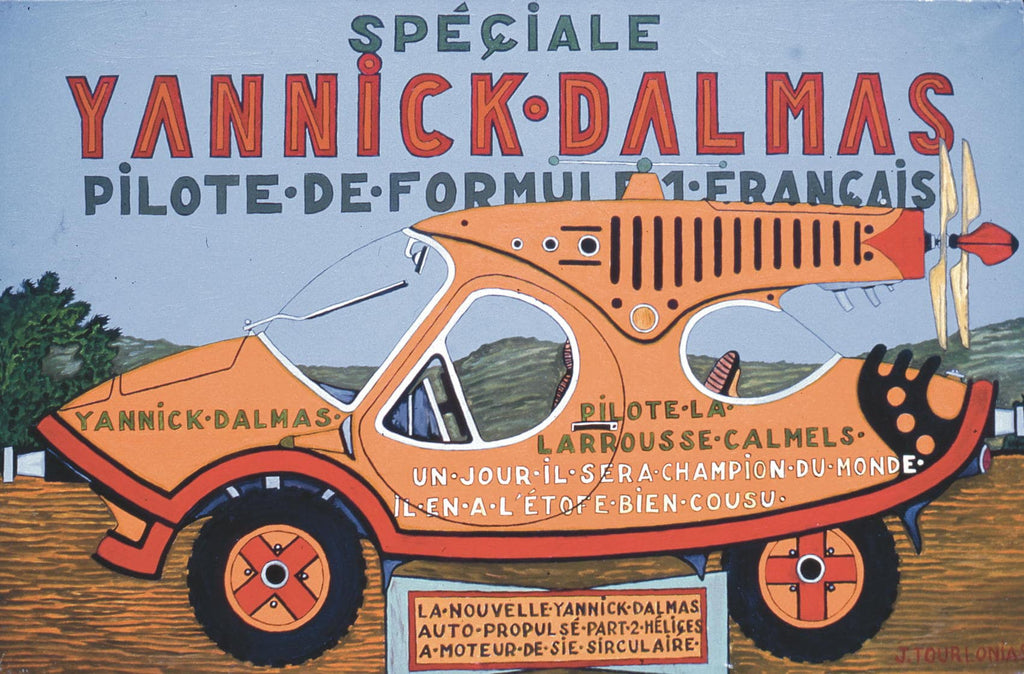First published: Winter 2022/23
French artist Tourlonias combined his passion for cars with his love of TV to create a very different kind of portrait
Jean Tourlonias was born in 1937 into a peasant family, living in the village of Cébazat, in the Auvergne region of central France. As a boy, he excelled in drawing at school but had to give up formal education so that he could help his parents on their farm. In his early twenties, he got called up to fight in the Algerian War of Independence, but within a year he fell ill, returned home to recover and began to work the land again. Around this time, a passing friendship with an amateur painter led him to turn his hand to art once again. He began to make paintings – mostly of his village and its inhabitants – but negative public reaction to his work led to him abandoning his paint brushes.

Spéciale Michel Thévoz Super Autobil Suisse, 1994, acrylic paint on waxed canvas, Collection de l’Art Brut
all images: 39.5 x 25.5 in. / 100 x 65 cm, oil paint on canvas; courtesy: Gallery Claire Gastaud
By now, the world had begun to change. With industrialisation came the gradual disappearance of villages and traditional methods of agriculture. Tourlonias tried working at a dairy cooperative for a while but ended up back on the family farm which had moved towards market gardening. During the day, he went to the market to sell the fruit and vegetable that they grew, advertising the produce with colourful placards that he had made; in the evening, he passed the time watching TV. He also liked to fish and to ride his motorbike, the latter leading him to buy various motoring publications. Inspired by his new passion, he began to draw racing cars. By then in his late thirties, he felt more able to ignore public opinion and had soon created his own universe of imaginary cars containing references from TV shows and car magazines.

Spéciale Yannick Dalmas, n.d.
Combining market gardening and painting was not easy and, in his early forties, Tourlonias took another break from art. He felt so dejected and disappointed at his constant failure to sell any of his creations that at one René Verdier spotted the work and, impressed, introduced him to local gallerist Daniel Gastaud. This would be the beginning of a long collaboration between Tourlonias and the Gallery Gastaud. He had solo exhibitions at the point he even considered burning them all.

Spéciale Oulala Mézoulalaya, 1987
His creative breakthrough did not come until 1986. He had returned to painting once again and was displaying his work – with the prices tacked directly on to the canvases – at the market, alongside his farm produce. A collector called gallery in Clermont-Ferrand in 1990, as well as at the found in private collections around the world. gallery La Pochade in Paris and in Abbaye Saint-Andé, and at Centre d’Art Contemporain in Meymac in 1991. He was also in several group shows, including “Les Instinctifs” at Museum Ingres in Montauban in 1989 and “SATCAT” in Clermont-Ferrand in 1991. Today, Tourlonias’ art can be found in private collections around the world.

Autoberliet (recto),1991, gouache and ballpoint pen on paper, 15.5 x 12.5 in. / 39.5 x 32 cm
After rekindling his passion for drawing and painting at the age of 49, Tourlonias never again stopped creating. He made works that were inspired by the life of the inhabitants of the Auvergne region, evoking the colourful, everyday images of the Épinal prints that were popular in nineteenth-century France. Gradually, however, human figures became rarer in his work, giving way almost wholly to vehicles.
By ALLA CHERNETSKA
This is an article extract; read the full article in Raw Vision #113




